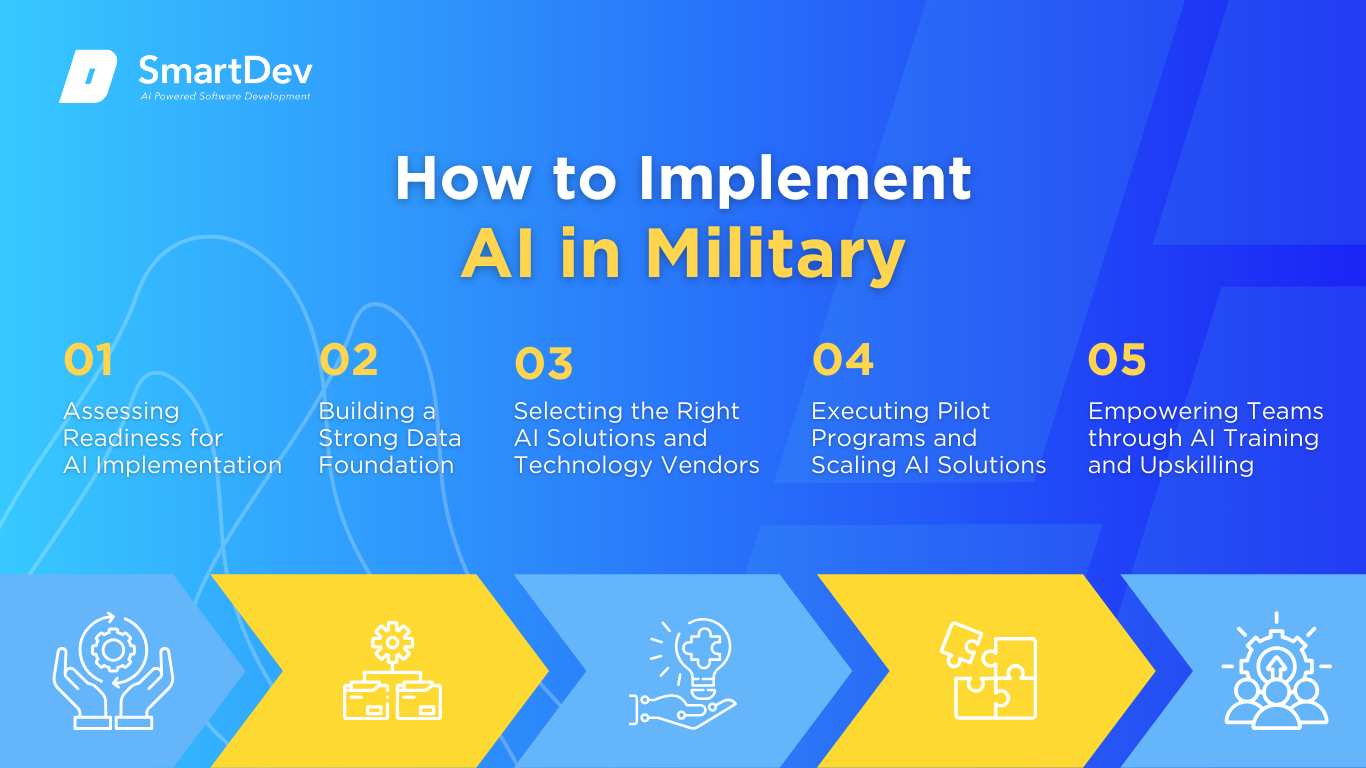Introduction
The military landscape is rapidly evolving. With increasing threats and the demand for more efficient and precise operations, traditional strategies are being augmented with cutting-edge technologies. AI in the military is no longer just an experiment; it’s becoming an integral tool transforming operations, decision-making, and defense strategies.
This comprehensive guide explores how AI is reshaping defense capabilities, enhancing operational effectiveness, and leading the charge into future warfare.
What is AI and Why Does It Matter in Military?

Definition of AI and Its Core Technologies
Artificial Intelligence (AI) refers to systems that emulate human cognitive functions such as learning, problem-solving, and decision-making. In the military context, AI encompasses technologies like machine learning, computer vision, robotics, natural language processing (NLP), and autonomous systems. These tools enable rapid data analysis, automate operations, and support complex decision-making, often in real-time.
In defense, AI is revolutionizing areas such as combat operations, logistics, cybersecurity, and intelligence gathering. Whether it’s autonomous drones executing missions, AI-powered systems predicting equipment failures, or cyber defenses mitigating threats, AI is enhancing the military’s ability to respond to a wide range of challenges quickly and effectively.
The Growing Role of AI in Transforming Military
AI is fundamentally changing how the military plans, executes, and manages operations. In combat, autonomous systems like drones, unmanned ground vehicles, and even robotic weapons are providing new ways to engage with threats without risking human lives. These systems use AI to navigate environments, process real-time data, and make decisions based on pre-set criteria, which enables them to operate in high-risk zones and perform missions autonomously.
The role of AI is also growing in intelligence gathering and surveillance. AI tools can analyze data from satellites, drones, and other sources to detect and track enemy movements, uncover hidden threats, and predict future activities. AI-enabled reconnaissance drones, for example, can autonomously search for targets, provide real-time information to commanders, and make battlefield decisions on the fly.
In cybersecurity, AI is a vital tool in detecting and mitigating cyber threats. By analyzing vast amounts of network data, AI systems can detect anomalies, predict potential breaches, and deploy countermeasures to prevent attacks. These capabilities are critical in modern warfare, where cyber warfare is increasingly becoming as significant as traditional combat.
Key Statistics and Trends in AI Adoption in Military
AI’s role in the military is accelerating, with increasing investments and applications across defense sectors. According to Grand View Research, the global AI in military market was valued at USD 9.31 billion in 2024, reflecting widespread adoption for key functions such as surveillance, combat, logistics, and cybersecurity. The integration of AI technologies into defense systems is expected to grow by 13% annually from 2025 to 2030 as militaries seek to enhance operational efficiency, reduce human error, and bolster defense capabilities.
One prominent trend is the expanding use of autonomous systems. In 2025, the U.S. Department of Defense allocated $4.9 billion for AI research and development, focusing on autonomous systems, AI-driven data analytics, and improved decision-making capabilities. The increasing reliance on AI in unmanned aerial vehicles (UAVs) and unmanned ground vehicles (UGVs) is expected to persist, particularly for reconnaissance and tactical support roles.
Moreover, AI-driven predictive maintenance is becoming integral to military logistics. By leveraging AI to anticipate equipment failures, the military can optimize repair schedules, minimize downtime, and ensure operational readiness. This approach is estimated to save the U.S. Department of Defense up to $5 billion annually in maintenance costs.
Business Benefits of AI in Military
AI brings significant operational advantages to the military by addressing longstanding challenges such as resource allocation, strategic decision-making, and operational efficiency. Below are five key business benefits of implementing AI in military operations:
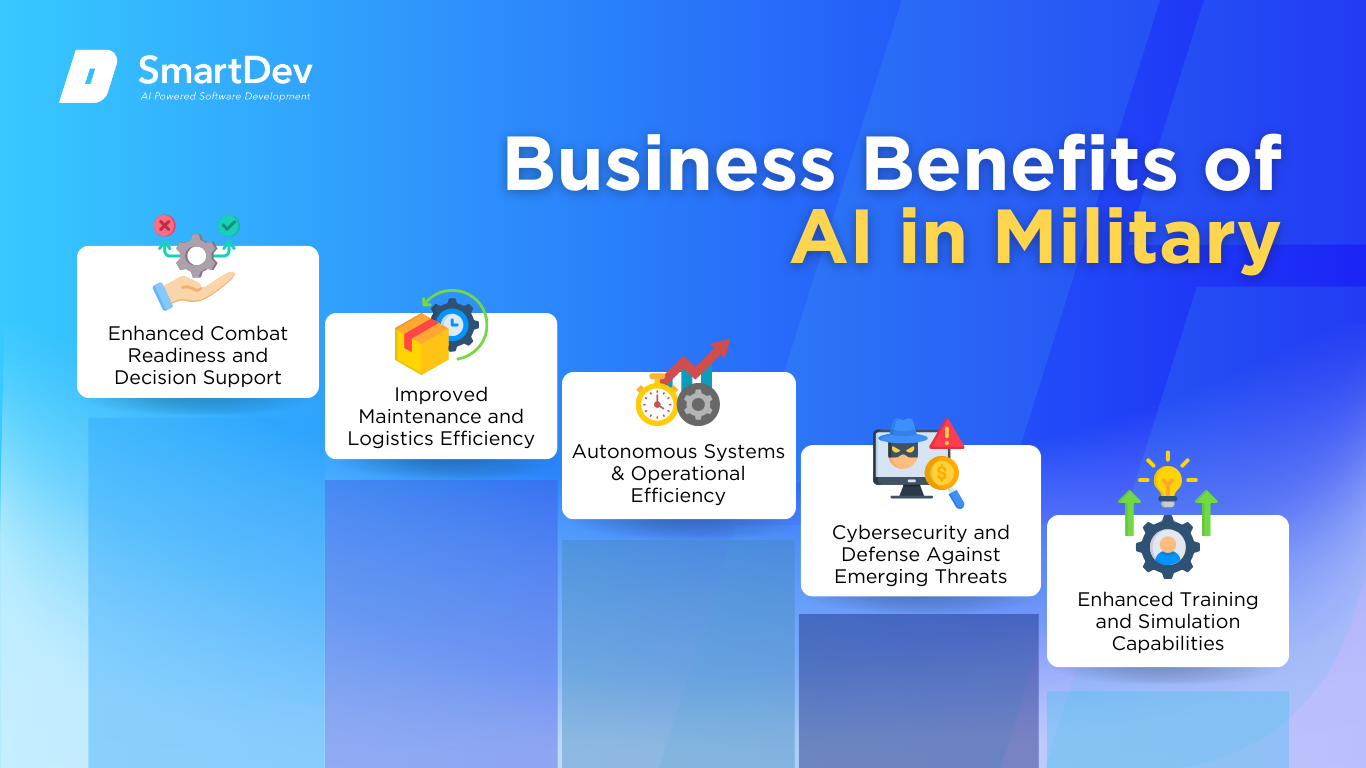
1. Enhanced Combat Readiness and Decision Support
AI significantly improves the speed and accuracy of military decision-making, especially in complex and dynamic environments. By processing real-time data from various sensors, AI systems provide actionable insights that help commanders make informed decisions faster. This results in better strategic planning and quicker reactions to changing conditions on the battlefield.
In addition to enhancing situational awareness, AI-driven decision support systems enable a more comprehensive understanding of potential threats. These tools can integrate data from multiple sources, including satellites, drones, and ground sensors, providing military leaders with a holistic view. By reducing decision-making time, AI ensures that the military can respond more effectively and efficiently in critical situations.
2. Improved Maintenance and Logistics Efficiency
AI-driven predictive maintenance tools help military forces anticipate and prevent equipment failures before they occur, ensuring higher levels of operational readiness. By continuously analyzing the condition of assets, such as vehicles, aircraft, and weapons systems, AI can predict when repairs or maintenance will be needed. This proactive approach reduces downtime and extends the life of critical military equipment.
In logistics, AI optimizes supply chains by predicting demand and improving resource distribution. By analyzing vast amounts of data, AI ensures that the right materials and supplies are delivered to the right locations at the right time. This streamlined process enhances operational efficiency, reduces delays, and ensures that military units are always well-equipped for their missions.
3. Autonomous Systems and Operational Efficiency
The integration of AI into autonomous systems, such as drones and unmanned vehicles, revolutionizes military operations by minimizing human risk and increasing operational capacity. These systems can perform missions that would be too dangerous or resource-intensive for humans, such as reconnaissance or supply drops in hostile environments. By relying on AI to control these systems, the military can expand its reach and capabilities without the direct involvement of personnel.
AI also enables autonomous systems to adapt to changing environments and mission requirements. By processing real-time data, these systems can make decisions based on conditions on the ground, adjusting strategies as needed. This autonomy not only increases mission success rates but also allows human resources to focus on more complex, high-level strategic tasks.
4. Cybersecurity and Defense Against Emerging Threats
AI plays a critical role in strengthening military cybersecurity by automating the detection and defense against cyber threats. It can identify unusual patterns of behavior or vulnerabilities in military networks, enabling quicker responses to potential cyberattacks. AI systems work continuously to monitor network traffic and assess risks, ensuring that defense infrastructure is not compromised.
In the evolving landscape of cyber warfare, AI’s ability to learn and adapt to new threats makes it an essential tool for proactive defense. These systems can detect new attack methods and counter them before they can cause significant damage. As the frequency and sophistication of cyber-attacks grow, AI’s role in defending military systems becomes increasingly vital for maintaining operational security.
5. Enhanced Training and Simulation Capabilities
AI-powered training systems provide more realistic and adaptive environments for military personnel to practice various scenarios without the need for live exercises. By simulating complex battlefield conditions, these systems enable soldiers to improve their decision-making, combat strategies, and teamwork skills in a controlled setting. AI allows for personalized training based on individual performance, creating customized learning experiences for each soldier.
These AI-driven simulations not only improve the effectiveness of training programs but also reduce costs and logistical constraints associated with traditional methods. By offering endless training opportunities without requiring physical resources, military forces can continuously enhance their readiness. AI ensures that personnel are better prepared for real-world operations by constantly challenging and refining their skills.
Challenges Facing AI Adoption in Military
Despite its potential to revolutionize military operations, AI adoption in the military faces several key challenges. These obstacles go beyond technical hurdles and encompass issues such as data availability, ethical concerns, and integration with existing systems.
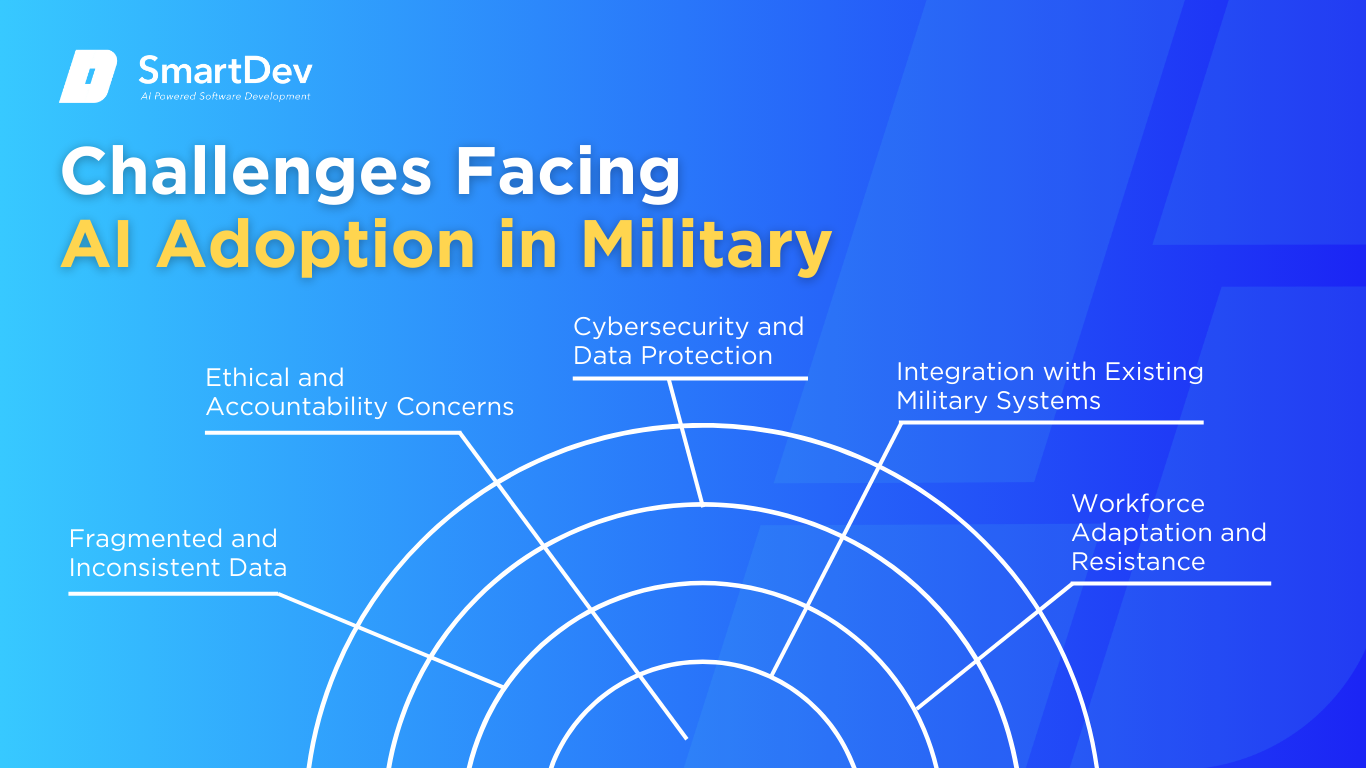
1. Fragmented and Inconsistent Data
AI systems in the military require high-quality, consistent data to function effectively. However, military data is often fragmented across different platforms, agencies, and operations, which complicates the process of data integration and analysis. Disparate data sources, incomplete information, and inconsistent formats can undermine the accuracy of AI systems, limiting their effectiveness in critical decision-making.
To address this challenge, the military must invest in creating centralized, standardized data repositories and improve interoperability between systems. This will ensure that AI algorithms have access to clean, unified data, which is crucial for accurate predictions and timely responses on the battlefield. Without such infrastructure, AI’s potential to enhance military capabilities could be severely limited.
2. Ethical and Accountability Concerns
The use of AI in military applications, particularly autonomous systems and decision-making processes, raises serious ethical and accountability concerns. In combat, the potential for AI-driven systems to make life-or-death decisions without human oversight can lead to controversial outcomes. The question of who is responsible if an AI system makes a mistake, such as targeting a civilian or malfunctioning during a mission, remains unresolved.
To mitigate these risks, it is crucial to establish clear frameworks for accountability, transparency, and human oversight in AI operations. Ensuring that AI systems are used as decision-support tools rather than fully autonomous agents can help balance the benefits of AI with the need for ethical governance. Effective regulation and guidelines are essential to ensure that AI is used responsibly in military contexts.
3. Cybersecurity and Data Protection
Military AI systems rely on vast amounts of sensitive data, and this creates significant cybersecurity risks. If AI systems are hacked or compromised, adversaries could manipulate critical defense strategies or gain access to classified information. Protecting AI systems from cyberattacks is crucial to maintaining national security, especially as military operations become more digitally reliant.
To address cybersecurity concerns, military organizations need to implement robust encryption, access control, and real-time threat detection systems. Additionally, AI itself can be used to identify and respond to cybersecurity threats more quickly than traditional methods. However, developing secure AI systems requires ongoing research and investment in defensive technologies to stay ahead of emerging threats.
4. Integration with Existing Military Systems
Many military organizations operate on legacy systems that were not designed with AI in mind. Integrating AI into these existing frameworks presents a significant challenge, as older technologies may lack the necessary infrastructure to support advanced AI capabilities. The complexity of this integration can delay AI deployment and create inefficiencies in military operations.
To overcome this challenge, the military must prioritize the modernization of its technological infrastructure. This includes upgrading legacy systems, ensuring compatibility with new AI tools, and providing training for personnel to effectively operate these systems. Successful integration will require significant resources, but it is essential for maximizing AI’s potential in modern military operations.
5. Workforce Adaptation and Resistance
The introduction of AI in military operations can lead to resistance from personnel who may fear job displacement or lack trust in automated systems. The military workforce may be reluctant to adopt AI tools if they perceive them as disruptive or difficult to understand. This resistance can hinder the effective implementation of AI technologies and delay their full adoption.
To address these challenges, it is important to focus on training and educating military personnel about the benefits and functionalities of AI. Ensuring that AI tools complement human decision-making rather than replace it will help alleviate concerns. Building a culture of trust and collaboration between AI and human operators is crucial for successful AI integration into military operations.
Specific Applications of AI in Military
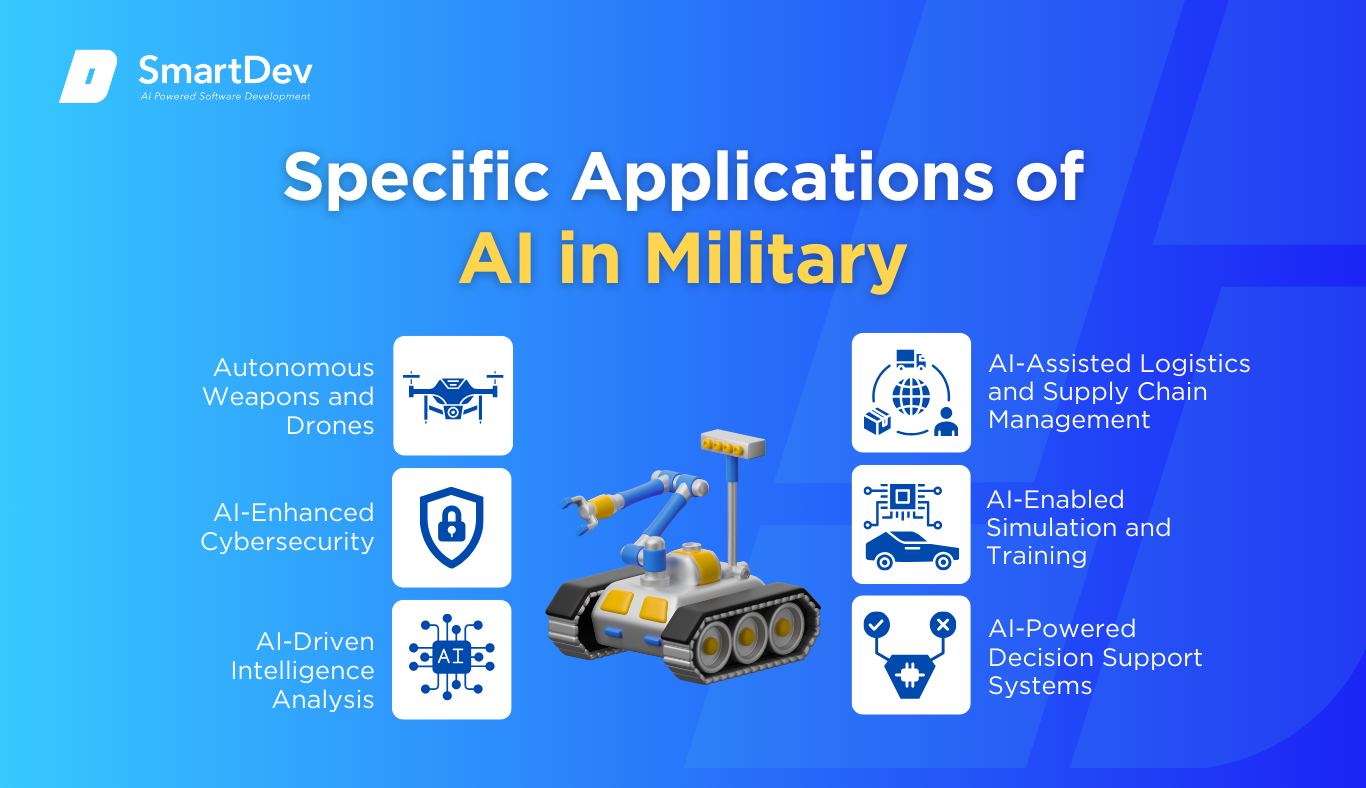
1. Autonomous Weapons and Drones
AI-powered autonomous weapons and drones are transforming military operations by enabling unmanned systems to perform tasks like surveillance, reconnaissance, and targeted strikes with minimal human input. These systems use machine learning algorithms and sensors to analyze their environment, identify threats, and make real-time decisions, reducing risks to personnel and improving operational efficiency. Autonomous drones can act quickly, targeting threats with precision, enhancing speed and accuracy in high-risk situations.
While the benefits are clear, the use of AI in autonomous weapons raises serious ethical concerns. Accountability becomes a challenge if a system makes a mistake or causes harm, and determining responsibility is not straightforward. Moreover, the potential for AI systems to malfunction or be manipulated by adversaries presents additional risks. This sparks debate over the need for regulations to ensure these technologies are used safely and ethically in military settings.
A real-world example is the U.S. military’s “Gremlins” program, which demonstrated AI-powered drones autonomously navigating environments and identifying targets. This program reduced human involvement in high-risk operations, showcasing the potential of AI to improve military efficiency while minimizing human casualties.
2. AI-Enhanced Cybersecurity
AI is integral to modern military cybersecurity, where it helps detect and respond to cyber threats more effectively than traditional methods. By analyzing large volumes of data in real-time, AI systems can identify patterns, detect anomalies, and predict potential cyberattacks. This enables military networks to be protected from increasingly sophisticated and fast-evolving threats, often before damage can be done.
However, as AI becomes central to cybersecurity, it also introduces vulnerabilities. Malicious actors could exploit AI systems, manipulating them to launch attacks or evade detection. Furthermore, the complexity of AI-based defense systems can make it challenging for military personnel to fully understand and control the technology, raising concerns over its reliability and transparency.
A real-world example is the use of AI in the U.S. Department of Defense’s “Project Maven”. This AI initiative helps detect and defend against cyber threats by analyzing massive amounts of data across various military networks. The project significantly improved response times to cybersecurity incidents, showcasing AI’s potential to bolster national defense against cyber warfare.
3. AI-Driven Intelligence Analysis
AI is revolutionizing intelligence analysis by automating the process of sorting through vast amounts of data from multiple sources. Machine learning algorithms can analyze satellite images, intercept communications, and even social media content to identify potential threats, patterns, or enemy movements, providing military commanders with more accurate, actionable intelligence in real time.
Despite its capabilities, reliance on AI for intelligence analysis raises concerns over data accuracy and algorithmic biases. If AI systems are not properly trained or if data quality is poor, the resulting analysis may be misleading, potentially putting military operations at risk. Additionally, the reliance on AI for strategic decisions could lead to overconfidence in technology and an underestimation of human judgment.
A real-world example is the use of AI by the U.S. military in analyzing satellite imagery for monitoring enemy movements. AI systems have been deployed to identify suspicious activities, such as the construction of military facilities, providing military intelligence officers with real-time insights and increasing operational efficiency.
4. AI-Assisted Logistics and Supply Chain Management
AI in military logistics optimizes the planning and delivery of resources, ensuring supplies reach the right locations at the right times. Machine learning algorithms analyze factors such as terrain, weather, and troop movements to predict the demand for supplies and optimize routes, reducing delays and ensuring efficient resource allocation.
However, relying on AI for logistics introduces risks if the systems malfunction or fail to adapt to rapidly changing battlefield conditions. AI systems may struggle to account for unexpected events or disruptions, potentially leading to resource shortages or delays in critical operations. Furthermore, the complexity of these AI systems can make it difficult for military personnel to intervene quickly if problems arise.
A real-world example of AI-assisted logistics is the use of predictive algorithms in military supply chains, which help ensure that vital resources like ammunition, food, and medical supplies are delivered efficiently to troops in remote or hostile environments. These systems have helped reduce delivery times by up to 25%, ensuring faster, more effective support during operations.
5. AI-Enabled Simulation and Training
AI-driven simulations are revolutionizing military training by providing realistic, adaptable environments where soldiers can practice tactics and decision-making. AI can simulate enemy strategies, terrain, and even unpredictable weather conditions, offering an immersive and dynamic training experience that prepares soldiers for a wide range of combat scenarios.
While AI-driven training simulations are highly effective, they may still lack the emotional and psychological components of real-life combat, which can limit their ability to fully prepare soldiers for the stress and unpredictability of actual warfare. Additionally, there’s a risk that reliance on AI-driven simulations might overshadow the importance of hands-on, real-world training.
A real-world example is the U.S. military’s use of AI-powered simulations in its synthetic training environments. These systems allow soldiers to engage in virtual combat scenarios with adaptive AI enemies, enhancing their decision-making skills and preparing them for a variety of combat situations. The technology has significantly improved training outcomes, helping soldiers refine their tactics and improve performance under pressure.
6. AI-Powered Decision Support Systems
AI-powered decision support systems are designed to help military commanders make faster, data-driven decisions during combat operations. By analyzing real-time data from various sources, such as battlefield reports, weather conditions, and enemy intelligence, AI systems can suggest strategies and optimize troop movements, helping to increase mission success rates.
Despite their potential, these AI systems are not foolproof. Decision support tools may rely on incomplete or inaccurate data, leading to suboptimal strategies or poor judgment calls. Additionally, excessive reliance on AI could undermine human intuition and strategic thinking, making commanders too dependent on technology for crucial decisions.
A real-world example of AI-powered decision support is the U.S. Army’s “Project Maven”. which analyzes large datasets to provide actionable intelligence to commanders. This AI system has been instrumental in improving decision-making speed and accuracy, reducing the time it takes to assess battlefield conditions and identify threats.
Need Expert Help Turning Ideas Into Scalable Products?
Partner with SmartDev to accelerate your software development journey — from MVPs to enterprise systems.
Book a free consultation with our tech experts today.
Let’s Build TogetherExamples of AI in Military
AI is becoming a foundational enabler in the healthcare sector, transforming diagnostics, patient care, operations, and pharmaceutical research. Below are three standout examples showcasing how leading organizations are leveraging AI to improve clinical outcomes, streamline workflows, and personalize treatment.
Real-World Case Studies

1. U.S. Department of Defense: Project Maven for Intelligence Analysis
Project Maven, implemented by the U.S. Department of Defense, uses AI to process large volumes of data from satellite imagery and other sources. Machine learning algorithms are employed to identify objects, detect anomalies, and classify threats in real-time, significantly enhancing the speed and accuracy of intelligence analysis. This has drastically reduced the time analysts spend reviewing imagery, allowing military personnel to act more swiftly and make informed decisions in high-pressure situations.
By automating image analysis, Project Maven has increased operational efficiency, enabling faster mission planning and execution. In one example, the system reduced the time required to analyze satellite images from hours to mere minutes, allowing the military to respond to critical threats with greater urgency.
2. U.K. Ministry of Defence: AI-Powered Cybersecurity
The U.K. Ministry of Defence (MOD) has implemented AI-powered systems to enhance its cybersecurity capabilities. These systems continuously monitor network traffic, detect anomalies, and predict potential cyberattacks in real-time. In the event of an attack, AI autonomously isolates affected systems, minimizing the damage and preventing the spread of the threat.
The implementation of AI in the MOD’s cybersecurity infrastructure has reduced the risk of cyberattacks on military networks, with a reported 40% improvement in response time. This has enabled the MOD to protect sensitive data and maintain operational continuity, even amid growing cyber threats from adversaries.
3. Israel Defense Forces (IDF): AI in Autonomous Combat Drones
The Israel Defense Forces (IDF) has integrated AI into its autonomous drone fleet to enhance surveillance, reconnaissance, and precision strikes. These drones are equipped with machine learning algorithms that enable them to autonomously identify targets, assess threat levels, and execute missions with minimal human oversight. This reduces the risk to soldiers and increases the operational efficiency of drone strikes.
In recent exercises, the AI-driven drones autonomously performed surveillance missions, detecting and engaging threats without direct human control. This capability has not only improved the speed and accuracy of military responses but also reduced the burden on human pilots, who previously had to manually control the drones.
4. Indian Army: AI for Border Surveillance and Security
The Indian Army has begun using AI-based systems for border surveillance, particularly in remote or high-risk areas. These AI-driven systems use machine learning and computer vision to analyze real-time footage from drones and cameras along the borders, identifying unusual movements, potential infiltrations, or other threats. The systems can autonomously track targets and alert soldiers to potential security risks, enhancing the effectiveness of border patrols.
During border operations, these AI systems have significantly improved surveillance coverage, enabling quicker detection of border breaches. They reduce human error and increase operational efficiency, especially in challenging terrains where human presence is limited. The integration of AI has also enhanced the Army’s ability to monitor vast areas with fewer resources, allowing personnel to focus on strategic decision-making and rapid response.
Innovative AI Solutions
AI-Driven Innovations Transforming Military
Emerging Technologies in AI for Military
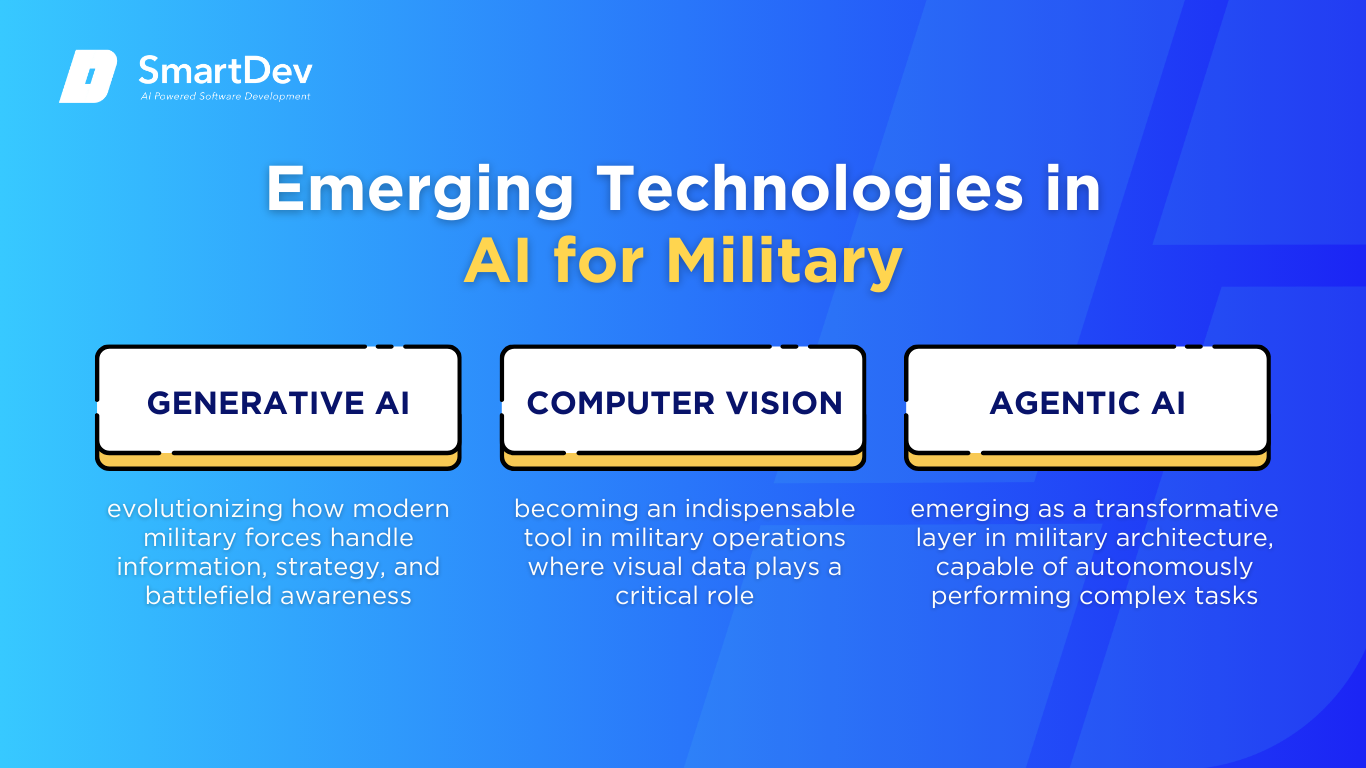
Generative AI is revolutionizing how modern military forces handle information, strategy, and battlefield awareness. These advanced models are capable of synthesizing vast datasets into actionable intelligence, generating situational reports, and supporting mission planning with scenario simulations. Instead of relying solely on human analysts, military teams are now able to leverage AI to uncover hidden patterns, forecast enemy maneuvers, and construct optimal response strategies within seconds.
Computer vision is becoming an indispensable tool in military operations where visual data plays a critical role. From aerial reconnaissance to real-time surveillance, AI-driven visual systems can identify objects, classify threats, and provide automated tracking with far greater precision than manual observation.
Agentic AI is emerging as a transformative layer in military architecture, capable of autonomously performing complex tasks across intelligence, logistics, and operations. These AI agents operate with contextual awareness, long-term memory, and tool-using capabilities that allow them to function semi-independently in high-stakes environments. As militaries evolve toward a more decentralized and responsive command structure, agentic AI offers a scalable way to multiply operational efficiency while minimizing human risk.
AI’s Role in Sustainability Efforts
AI is playing an increasingly strategic role in driving sustainability across military operations by minimizing resource waste, improving logistics, and enhancing mission efficiency. Through predictive analytics, defense organizations can forecast equipment maintenance needs, supply chain disruptions, and resource demands based on real-time operational data.
Energy efficiency is another critical area where AI is reshaping sustainability practices in defense infrastructure. Smart base management systems use AI to monitor and adjust energy usage across barracks, command centers, and operational facilities. These systems adapt HVAC, lighting, and power distribution based on occupancy and mission schedules, dramatically reducing emissions and utility costs.
How to Implement AI in Military
Step 1: Assessing Readiness for AI Adoption
Before launching AI initiatives, military leaders must identify where AI can deliver real impact. Areas like logistics, surveillance, maintenance, and strategic planning are ideal starting points. These functions are repetitive, data-intensive, and time-critical—making them perfect candidates for automation.
Readiness also depends on infrastructure, data maturity, and team alignment. Conduct internal audits to assess system compatibility and leadership support. A clear vision and strong coordination across units will reduce resistance and improve execution.
Step 2: Building a Strong Data Foundation
A solid data foundation is essential for any military AI strategy to succeed. Begin by mapping data sources—from intelligence and logistics to weather and field operations. Understanding how data flows across systems helps reveal gaps and integration opportunities.
Once visibility is achieved, focus turns to data hygiene. Standardize data formats across systems, clean historical records of errors or duplication, and ensure robust governance protocols to manage sensitive or classified information. Military data often resides in compartmentalized or legacy systems, so interoperability must be addressed early.
Step 3: Choosing the Right Tools and Vendors
Selecting AI tools in the military means balancing innovation with operational security. Platforms must match mission goals and integrate with existing systems without disruption. Cloud, edge computing, and secure comms must all be considered from day one.
When choosing vendors, prioritize those with proven defense experience. Look for companies that understand command workflows and regulatory demands. The best partners offer long-term support—not just software delivery.
Step 4: Pilot Testing and Scaling Up
Avoid jumping straight to full deployment—start small and focused. Run pilot programs in contained units to test performance, reliability, and ease of use. This lets you gather feedback, refine systems, and build internal confidence.
Track results using clear KPIs like mission speed, detection accuracy, or cost savings. If successful, scale gradually across bases or theaters of operation. A phased rollout avoids disruption and allows adjustments in real time.
Step 5: Training Teams for Successful Implementation
Introducing AI into defense is as much about people as it is about tech. Soldiers, analysts, and commanders need practical training to interpret and trust AI outputs. Real-world scenarios and clear escalation rules help build confidence.
Just as important is fostering a culture that sees AI as an ally, not a threat. Involve users early, show quick wins, and highlight how AI enhances—not replaces—human judgment. With trust and hands-on training, your teams become active AI operators, not passive users.
Measuring the ROI of AI in Military
Key Metrics to Track Success
Assessing ROI for military AI requires a balanced view of mission effectiveness, operational efficiency, and cost impact. One key indicator is productivity—how much faster logistics planning or intelligence analysis can be executed after AI integration. By comparing mission timelines and resource usage before and after deployment, commanders gain clear insight into AI’s tangible benefits.
Cost savings also matter significantly. AI can reduce personnel hours spent on repetitive tasks like data processing or route planning, which lowers labor and operational costs. Efficient AI tools also reduce equipment downtime, further stretching defense budgets.
Operational readiness serves as another important metric. Enhanced decision-making through AI often leads to improved response times and fewer mission-critical errors. This strengthens overall force capability and underpins long-term strategic advantage.
Case Studies Demonstrating ROI
In one deployment, introducing AI-driven logistics forecasting cut fuel resupply delays by nearly half during training operations. This sped up mission timelines and reduced operational bottlenecks without increasing manpower. Command leadership recognized improved readiness and flexibility as direct results of AI adoption.
Another example saw AI-enhanced surveillance systems reduce target identification errors during field exercises. That resulted in faster engagement cycles and fewer false alarms. Units reported increased trust in automated analysis and better mission outcomes.
A third case involved predictive maintenance AI for armored vehicles, which flagged failing components before breakdown. The prevention of in-field vehicle failure saved time, decreased repair costs, and improved platoon availability. Overall, units noted higher operational uptime and smoother mission execution.
Common Pitfalls and How to Avoid Them
One common pitfall is deploying AI without linking it to specific operational problems, leading to wasted effort and minimal ROI. Every AI initiative must start with a clear mission challenge, success criteria, and logical value hypothesis. This keeps teams focused and outcomes measurable.
Another risk is reliance on poor-quality or siloed data that misleads decision-making or reduces trust in the AI system. Standardizing, cleaning, and securing data early ensures model outputs are accurate and reliable. Regular data audits and governance help maintain long-term model performance.
Cultural resistance among operators can also hinder adoption. Military personnel may distrust systems they don’t understand or fear replacement by automation. Engaging units early, offering hands-on training, and celebrating operational wins helps build confidence and establishes AI as a force multiplier, not a threat.
Future Trends of AI in Military
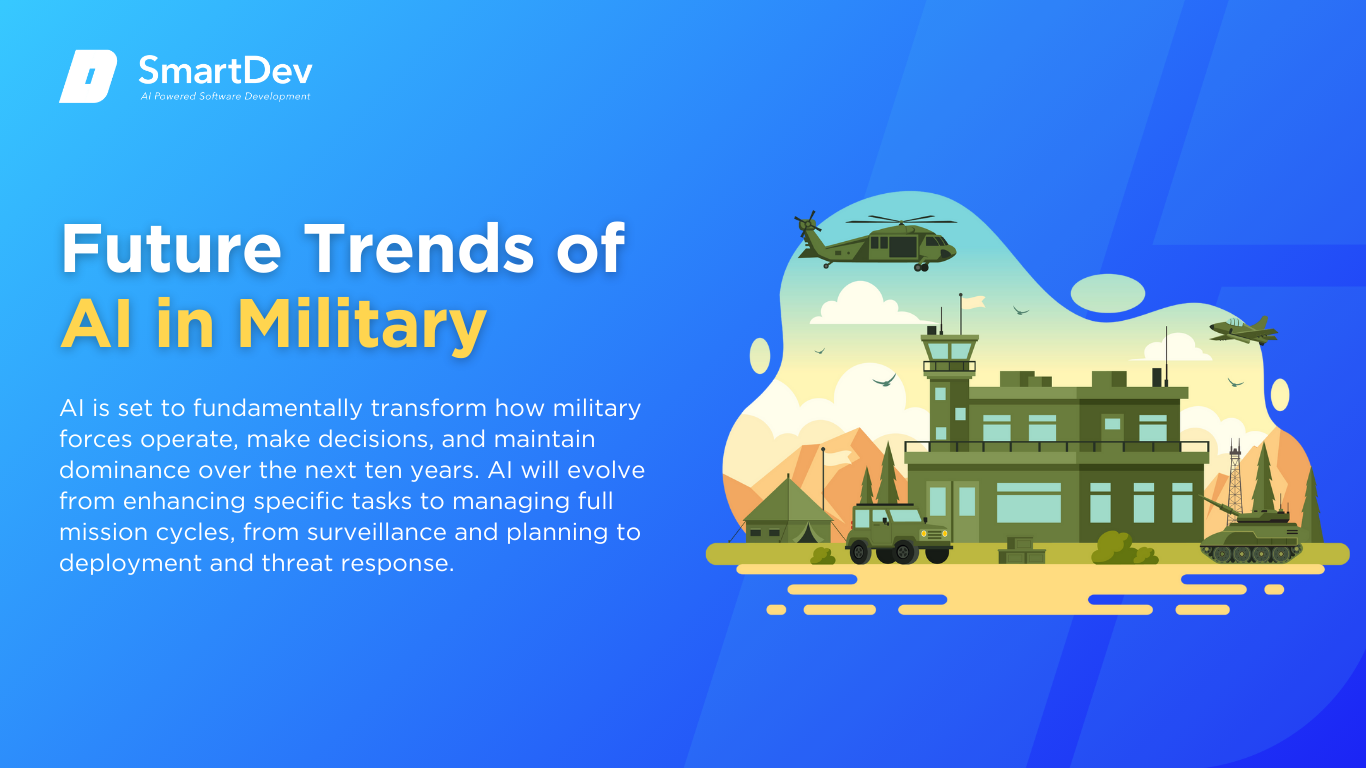
Predictions for the Next Decade
AI is set to fundamentally transform how military forces operate, make decisions, and maintain dominance over the next ten years. AI will evolve from enhancing specific tasks to managing full mission cycles, from surveillance and planning to deployment and threat response. We’ll also see AI systems becoming more autonomous, context-aware, and capable of coordinating across air, land, sea, cyber, and space domains simultaneously.
AI will increasingly integrate with edge computing, satellite imagery, and autonomous weapons systems, allowing real-time responses without central oversight. Large language models trained on military doctrine will assist in command decision-making, information synthesis, and operational planning. These systems will proactively adjust strategies, anticipate adversary actions, and optimize force positioning based on live battlefield conditions.
As AI becomes more agentic and strategic, it will lead to faster operational cycles, reduced human risk, and more precise engagements. Global defense alliances will adopt AI to coordinate joint operations, monitor geopolitical threats, and manage cyberwarfare autonomously. Militaries that master this AI convergence will gain unmatched tactical and strategic advantages.
How Businesses Can Stay Ahead of the Curve
To stay ahead, defense organizations must embed AI into core strategy—not just individual initiatives. This means moving from isolated pilot programs to long-term, AI-first doctrine development, force structuring, and warfighting concepts. Leadership must view AI not as a tool, but as a central pillar of future readiness.
Developing internal AI talent, securing multi-domain data infrastructure, and working closely with defense tech innovators will be essential. Open architecture systems and secure interoperability will give militaries the flexibility to evolve with the tech landscape. Partnering with allies, academic labs, and ethical oversight bodies will ensure AI development remains safe, effective, and aligned with national interests.
Conclusion
Key Takeaways
AI is redefining the military landscape by accelerating decision-making, enhancing situational awareness, and reducing operational costs. From predictive maintenance and logistics optimization to autonomous systems and strategic intelligence, AI is a core enabler of mission success. Defense forces that embed AI into daily operations are gaining speed, precision, and resilience across every domain of warfare.
Organizations that invest in clean data, align AI with real tactical challenges, and prepare their teams for digital collaboration are seeing measurable returns in readiness and resource efficiency. As AI evolves from assisting specific functions to coordinating entire mission cycles, its adaptability and autonomy will shape the next generation of warfare.
Moving Forward: A Strategic Approach to AI in Military
If your organization is ready to fully harness the power of AI in defense, now is the time to move from pilots to purposeful integration. Start by identifying mission areas where AI can deliver fast, reliable impact, whether through autonomous surveillance, real-time decision support, or smarter logistics. Build a robust data infrastructure, foster a digitally fluent workforce, and partner with experts who understand the complexity of military-grade AI.
At SmartDev, we collaborate with defense innovators, tactical units, and command leaders to create AI strategies that are secure, scalable, and mission-aligned. From choosing the right technologies and launching field pilots to training personnel and measuring ROI, we support your AI journey from concept to combat readiness. Whether you aim to enhance strategic planning, increase force agility, or stay ahead of evolving threats, our solutions are built for your mission.
The future of defense is autonomous, intelligent, and data-driven. Let’s lead it together.
—
References:
- The Role of Artificial Intelligence in Military Systems: Impacts on National Security and Citizen Perception | ResearchGate
- Artificial Intelligence in Military Market Report | Grand View Research
- India’s AI Dream: How the U.S. Pentagon’s $11 Billion AI Space Budget Impacts India’s Defence Strategy | IADB
- DARPA Gremlins Program to Create Overwhelming Drone Swarms | DSIAC
- Project Maven to Deploy Computer Algorithms to War Zone by Year’s End | U.S. Department of Defense
- Israel Developing AI-Powered Tech to Predict Threats, Prevent Attacks | The Jerusalem Post
- Artificial Intelligence in Defence Modernisation | KPMG India
- Ministry of Defence to Use AI-Powered Data Control | UKAuthority

